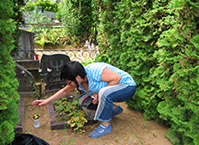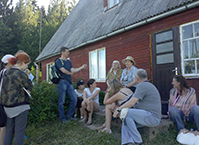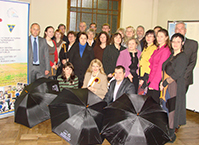About potter's work
Categories: Study and work, Peteris Gailums
Story-teller: “The dishes should be absolutely dry to put them into the kiln, just like this. If they are like these ones and they are put into the kiln, they will certainly break. And then, the next work, when they, the first work to do, of course, is to throw them. That takes the least time of the whole process, to throw them it is the fastest. A lot of time is necessary to attach the loop, even more time is necessary to polish everything so that no fingerprints are left, nothing, for it to be, to look good. It is the most time-consuming. And it turns out that every, even the smallest earthenware piece should be taken into hands at least ten times and some work is to be done from the moment when I throw it on my potter’s wheel to the moment when I take it out from the kiln. Now, you see, here they are in the process of drying. Now, that they are made, I have two kilns, let’s go to the big kiln. Later we can go and see the small one, too. Some dishes are left… we’ll see later.. A bodyguard.. Please, come in. The bodyguard follows me, he won’t do anything, err, she.. This is what the kiln looks like. Most of you must have seen a kiln before.”
Story-teller: “Be careful! Don’t hit the head! I’ll tell you, how the whole process proceeds, even if you have one, maybe, you have seen one, but maybe nobody has told you how the things happen. Well, and this is the big kiln. It is usually used to fire those earthenware pieces that have glaze, not the black ones, but those with the glaze. Err, so that I could heat that kiln, I have to work for about a month; and to fill up one kiln, some 150-200 earthenware pieces are necessary. If the kiln is about this size, then, it means, 200 pieces. If earthenware pieces are bigger, that it can be different, there could be less. And then, before firing, they should be dried perfectly, the best variant, that they are left somewhere, not in the direct sun, but in a shady place for three of four days. Then they gradually dry and don’t crack. But now I am speeding up, because I have to do everything faster, and therefore I place them in the sun. But the sun today is not very hot, then it is normal.
Therefore, consequently, I dry those earthenware pieces and then, before placing them into the kiln, I, err, cover them with glaze. And that glaze, so that it would be easier to understand, is a very very thin layer of glass. Because the main constituent of the glaze is quartz sand, which is also used to produce glass. And, for pottery to be colourful, in many colours, different oxides are added to that glaze. Iron oxide or simple rust, which, you see, is everywhere here, it adds yellow or brown tint. Copper oxide gives green tint and cobalt – blue and manganese – reddish brown. And then, if, let’s say, I glaze in that big kiln, then it takes three or four days to glaze everything. The glaze is, in most cases, liquid. I rarely use the dry one. The dry glaze is the traditional glaze in Latgale. But, I work with it very little. And, it is of such consistency as fresh cream. At first, the glaze is put from within the piece of pottery. That glaze is simply poured into and then it is turned and the glaze is slowly poured out. And, since the crock is dry, the glaze sticks to it in the layer of necessary thickness. And then, from outside it can be done by pouring over, or can, but I usually do that by pouring over.
So, and, when all that has been done, then we put it into the kiln. Onto the bottom level. Those that are closer, but it is not necessary there.. The biggest pieces of pottery, they can be of approximately this height, they could be also bigger, it depends. And thus, the first level is placed. And the rest are placed, you see – there are a lot of boxes there in the back; it is not ordinary metal, it is nichrome. Ordinary metal does not endure such temperatures. And, correspondingly, a box is chosen depending on the size of the piece of pottery. Thus, the whole kiln is filled up to the top and then on the top, the top is covered with grates, the grates like these. And the very top is covered with shards. This is the way shards are put and it is, it is necessary, as potters laugh, the kilt is covered with a fur coat, so that it is warm. But, practically, it is necessary for the fire not to go out at once, for it to stay inside. Otherwise, if there were no shards, the fire would “run” out very quickly and then it would be necessary to be stoking maybe for two days, maybe three, who knows. Nobody has ever tried it and I think nobody will ever do that.”
Images
Audio
Researcher: Dr. philol. Gatis Ozoliņš, Daugavpils Universitāte













